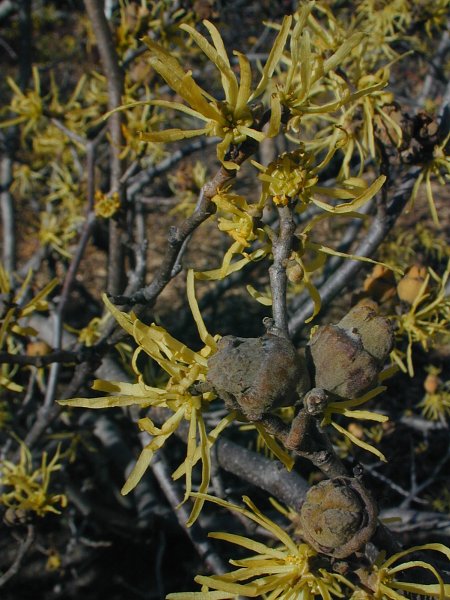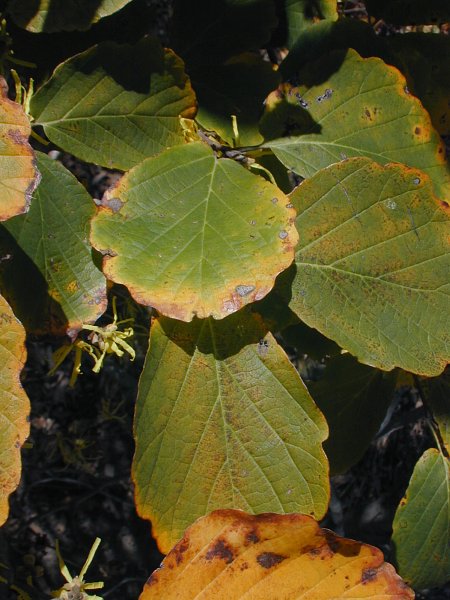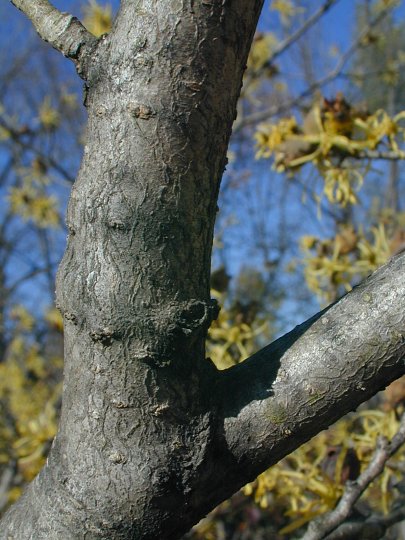Description: This woody plant is a shrub or small tree up to 20' tall. It is usually abundantly branched and rather bushy in appearance. Witch-Hazel may have a single trunk up to 1' across, or there may be several ascending branches at its base. The trunk and/or larger branches are grey, relatively smooth, and slightly wrinkled. The smaller branches and twigs are grey to reddish brown. The alternate leaves are up to 5" long and 3" across; they are oval to broadly obovate in shape and wavy-toothed along their margins. The upper surface of each leaf is medium to dark green and hairless; the lower surface is pale green and hairless, or pubescent along the major veins of the leaf. The base of the leaf blade is often asymmetrical. The slender petiole of each leaf is up to ¾" long. Small clusters of yellow flowers and brown seed capsules develop along the upper branches and twigs. Each flower has 4 yellow petals, 4 yellow sepals, 4 fertile stamens, and a pair of short styles. The tape-like petals are about ¾" long and linear in the shape; they are often contorted and twisted, rather than straight. The sepals are much smaller in size, broadly triangular, and recurved while the flower is blooming. The stamens are quite short. The blooming period occurs from mid- to late fall for about 3 weeks. This is the last woody plant to bloom during the fall; this usually occurs shortly after its leaves turn yellow and have fallen to the ground. After the flowers have withered away, some of them are replaced by seed capsules that require an entire year to mature. A mature seed capsule resembles a brown woody acorn about 2/3" (17 mm.) long; the upper third of this capsule is divided into 4 segments. Inside, each seed capsule has 2 cells; each cell contains a single seed. Mature capsules explode, ejecting the seeds about 10-20 ft. away. This typically occurs during the autumn while the flowers are blooming. The seeds are up to ¼" long, ellipsoid, shiny, and black. The root system consists of a woody branching taproot. This shrub/tree spreads by reseeding itself.

Cultivation: The preference is light shade to partial sun, mesic conditions, and sandy or loamy soil. More flowers are produced in response to greater amounts of sunlight.
Range & Habitat: The native Witch-Hazel is uncommon in central and northern Illinois, while in the southern part of the state it is rare or absent (see Distribution Map). Illinois lies along the western range limit of this species; it is more common further to the east. Habitats include typical woodlands and sandy woodlands, typical savannas and sandy savannas, woodland borders, wooded slopes, stabilized foredunes near Lake Michigan, and restored woodlands. Witch-Hazel is occasionally cultivated as an ornamental shrub/tree in yards or along buildings.

Faunal Associations: The nectar and pollen of the flowers attract primarily flies and parasitoid wasps, including biting midges, non-biting midges, march flies, scuttle flies, fungus gnats, dark-winged fungus gnats, black flies (Simuliidae), flower flies (Syrphidae), Tachinid flies, flesh flies, Calliphorid flies, Muscid flies, Anthomyiid flies, dung flies, ensign flies, frit flies, lance flies, Braconid wasps, Eulophid wasps, Platygastrid wasps, Pteromalid wasps, and Ichneumonid wasps. Other pollinating insects that have been observed visiting the flowers of Witch Hazel include Halictine bees, bumblebees, honeybees, and miscellaneous beetles (Graenicher, 1900-1909; Anderson & Hill, 2002; Wilhelm & Rericha, 2017). Other insects feed destructively on the foliage and other parts of Witch Hazel. These species include a leaf beetle (Scelolyperus meracus), various plant bugs, a leafhopper (Eratoneura marra), and several aphids, including Hormaphis hamamelidis (Witch Hazel Cone Gall Aphid) and Hamamelistes spinosus (Witch Hazel Spiny Gall Aphid). A seed-eating weevil (Pseudanthonomus hamamelides) also feeds on this shrubby tree (Clark et al, 2004; Knight, 1941; Wheeler et al., 1983; Dmitriev & Dietrich, accessed 2010; Blackman & Eastop, accessed 2013; Pepper, 1965; De Steven, 1981). In addition to these insects, the larvae of the Witch Hazel Dagger Moth (Acronicta hamamelis) and several other moths also feed on Witch Hazel (see Moth Table).

Among vertebrate animals, several birds eat the seeds of this shrubby tree, including the Northern Cardinal, Bobwhite Quail, Ruffed Grouse, Wild Turkey, and Ring-necked Pheasant (DeGraaf, 2002). Among mammals, the White-tailed Deer browses on the twigs of this shrub, while the Fox Squirrel feeds on the seeds (Martin et al., 1951/1961). Because Witch Hazel has relatively large leaves and a fairly dense branching structure that is low to the ground, it provides cover for a variety of wildlife.
Photographic Location: A garden at Crystal Lake Park in Urbana, Illinois.
Comments: Witch-Hazel provides abundant green foliage during the summer and attractive flowers during the autumn when little else is in bloom. The seed capsules resemble miniature cannons that expel their seeds with considerable force, making an audible sound. This unique woody plant can't be confused with anything else in Illinois.